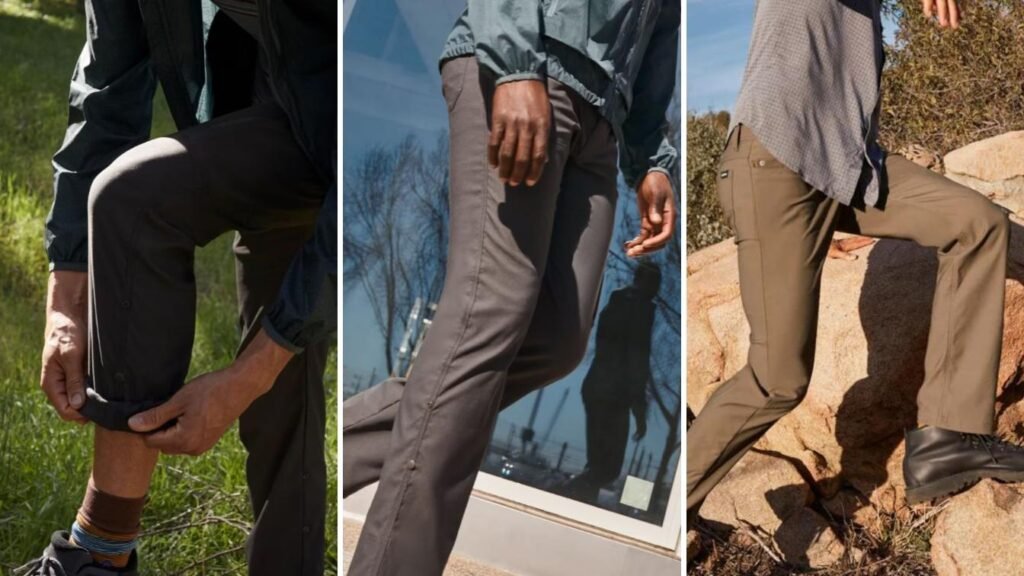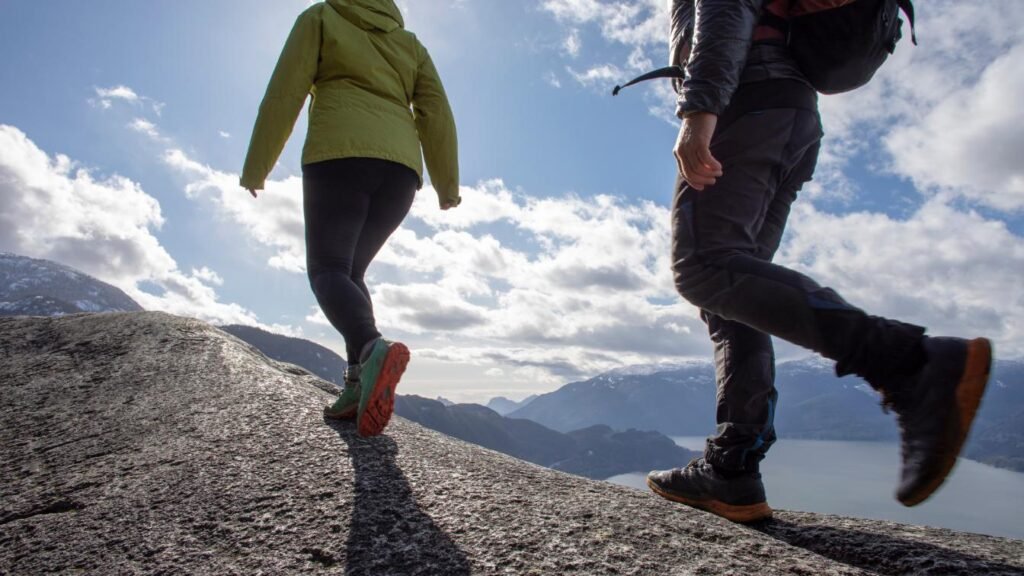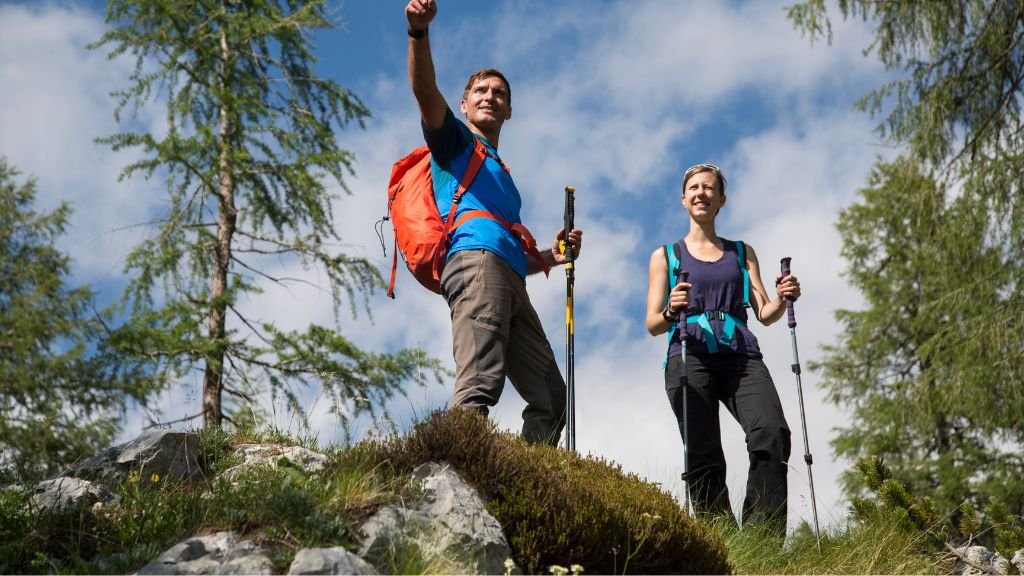Hiking pants are a must-have for almost any trail. They protect you from the elements, provide comfort and mobility, and keep you warm or cool depending on the weather conditions.
But with so many options available in the market, how do you choose the right hiking pants for your needs?
You don’t need to be a gear guru to sort it out. We’re about to dive into practical, no-nonsense advice on picking the hiking pants that’ll keep you comfy, mobile, and ready to conquer peaks without a pinch or a snag.
How to Choose Hiking Pants? 4 Key Factors
To choose hiking pants, consider your hiking plans, weather conditions, and the environment. Think about the type of hiking you’ll be doing, such as day hikes or mountain climbs and make a decision based on that.
Material matters too, with options like nylon for durability, polyester for moisture management, and spandex blends for stretch.
| Hiking Activity | Desired Pant Features | Material Choices | Weather and Location Considerations | Additional Tips |
|---|---|---|---|---|
| Day Hiking | Lightweight Breathable Quick-dry | Nylon Polyester Spandex blend | Adjust to current weather forecast UV protection for sunny days | Stretchable fabric for ease of movement If trails are easy, prioritize comfort |
| Backpacking | Durable Cargo pockets Reinforced seams Convertible to shorts | Ripstop nylon Polyester with DWR coating | Varying climates: layered system with a base layer and shell Expect to encounter different weather patterns | Good fit for carrying a backpack Water-resistant if passing through wet areas |
| Mountaineering | Windproof Water-resistant Insulated options for cold Integrated gaiters for high snow | Gore-Tex Softshell Hardshell | Alpine conditions: insulated for cold, high-wind resistance Consider full waterproof pants for snowy or icy conditions | Fit should allow for full range of motion and layering underneath Bright colors for visibility |
| Desert Hiking | Light-colored to reflect sun UPF-rated for sun protection Vented for cooling | Breathable cotton blends Nylon with UPF rating | Hot and sunny: maximize cooling and sun protection | Loose fit can be beneficial for air circulation Some prefer long pants for protection against the sun and sand |
| Forest Trekking | Bug-resistant fabric Thicker weave for scratch protection Quick-dry for damp environments | Thick polyester Treated fabrics for bug resistance | Humid and buggy: built-in bug repellent Thorns/branches: thicker fabrics | Darker colors may hide dirt but can attract mosquitos Pockets with zippers to secure items from loss |
| Wet and Muddy Trails | Water-resistant Mud-resistant Easy to clean Gaiters compatibility | Waterproof-breathable materials Nylon with DWR finish | Expecting rain: look for sealed seams Muddy conditions: choose pants that won’t stain easily | Ensure pants can be tucked into boots or secured to keep out debris Quick-dry features to handle splashes or stream crossings |
Let’s take a closer look at all factors that you should take into account while choosing the best hiking pants.
Understand Your Needs
Before you buy hiking pants, think about the kind of hiking you plan to do. Will you go on day hikes, backpack on long trails, or climb mountains? Each type needs different pants.
Also, consider the weather. You might need light pants for hot days or insulated ones for cold times.
Different places like deserts, mountains, or forests also matter.
- In a desert, you want pants that keep you cool and block the sun.
- In a forest, look for pants that protect you from thorns and bugs.
- In the mountains, you might need pants that resist wind and water.
Material Matters
Hiking pants come in materials like nylon, polyester, and spandex blends.
- Nylon is tough and can handle rough trails and rocks with ease.
- Polyester manages moisture well. It draws sweat away from your body to keep you dry.
- Spandex blends give you stretch. They move with you as you hike.
Breathable and quick-dry fabrics are important too. When you sweat, these fabrics help air get to your skin and dry the moisture fast. This keeps you comfy while you hike.
Fit and Comfort
Pick pants that fit well but also let you move. Slim fit hiking pants are a good option, but make sure you can bend and step without tightness.
Look for pants with an adjustable waistband. This helps the pants fit right even if you gain or lose a little weight.
Features like articulated knees bend easily. Gusseted crotches give extra space where you need it most. Both help you move freely.
Technical Features
Some hiking pants have special features:
- UV protection blocks harmful sun rays.
- Water-resistant materials help you stay dry in rain.
- Zip-off legs turn pants into shorts when it gets hot.
- Pockets keep your stuff safe.
- Ventilation options like zippers or mesh areas let cool air in to keep you from overheating.
UV protection simply keeps your skin safe. If a surprise rain happens, water-resistant pants stop you from getting soaked. When the sun gets too hot, zip off the legs and change into shorts. It’s all about having the right features for a better hike.
What Makes Good Hiking Pants?
Durability
When you choose hiking pants, make sure they are tough. They should last through many trips and handle rough places without getting torn. You want strong pants that can take a beating from rocks, branches, and dirt.
Here’s how to spot tough hiking pants:
- Look for reinforced stitching at the knees and the seat. These areas get a lot of wear and tear.
- Ripstop fabrics are a good choice. They have a special weave that stops small tears from getting bigger.
- Check if the material feels thick and sturdy but not too heavy.
Weather Adaptability
Your hiking pants should fit the weather. In rain or snow, waterproof pants keep you dry. When it’s cold, you need warm pants, maybe even with a fleece lining.
For changing weather, layering is smart. Start with a light base layer for warmth. Then put on your hiking pants. If it gets really cold, add another layer over your pants.
Tips for picking weather-ready pants:
- Water-resistant material is great for light rain.
- For heavy rain or snow, look for waterproof labels.
- Pants with zip-off legs work well in both hot and cold weather. Use them as shorts when it’s warm and full pants when it’s cold.
Practicality and Functionality
Good hiking pants are practical. They have enough pockets to carry what you need. Pockets should be easy to reach and secure so you don’t lose your stuff.
Some pants change into shorts. This is useful when you start early in the cool morning and it gets hot later. Convertible pants let you adapt without changing your whole outfit.
A built-in belt or loops for suspenders help keep your pants up. This is important when you’re moving a lot. You don’t want to stop every few minutes to pull up your pants.
Style and Personal Preference
Even though how the pants work is most important, you also want to like how they look. If you think your pants look good, you’ll feel better wearing them.
It’s okay to choose pants that go with your style as long as they’re still right for hiking. Find a balance between looks and function. Pick pants that do their job and make you happy.
When you shop for hiking pants, use these tips to find ones that will last, protect you from the weather, hold your things, and make you feel confident.
Tips for Trying On and Testing Hiking Pants
When you try them on, you need to check if they fit well with your hiking boots and socks. Comfort is always king when you are out on the trails.
Checking for Compatibility and Comfort
Try these steps in the store:
- Wear the hiking boots and socks you plan to use.
- Pull on the hiking pants over your socks and lace up your boots.
- See if the pants stay over your boots when you move.
- Make sure the bottom of the pants doesn’t drag on the floor.
Comfort goes along with how the pants work with your boots. You don’t want your pants to ride up or be too tight over your boots.
Testing Fit and Mobility
When you have the right boots and socks, it’s time to move around. This is how you find out if the pants let you move freely.
Do these movements to test your pants:
- Squat down: Sit like you’re by a campfire. Your pants should not pull at the knees or waist.
- Stretch your legs: Step wide and reach up high. Your pants should move with you.
- Walk around: Take a few laps around the store. Feel if the pants rub or pinch as you walk.
- Sit down: Pretend you’re taking a break on the trail. The pants should not be tight behind your knees.
When you do all these moves, your hiking pants should feel easy to wear. If they bind, pinch, or sag, try a different pair.
Care and Maintenance of Hiking Pants
Your hiking pants work hard to keep you safe and comfortable on the trail. Take good care of them, and they will last a long time. Here’s how to wash, store, and fix them.
Washing Instructions
Clean hiking pants after each trip. Follow these steps:
- Empty your pockets: Check for any trash or small items.
- Close all zippers and fasten all buttons: This helps protect the pants during wash.
- Turn inside out: This reduces wear on the outer fabric.
- Use a gentle detergent: Avoid strong cleaners that can harm the fabric or water-resistant coating.
- Wash on a gentle cycle with cold water: Hot water can damage the material.
- Air dry if possible: Heat from a dryer can hurt the fabric. If you must use a dryer, pick a low heat setting.
If your pants are water-resistant, you might need to renew the coating after several washes. You can find spray products for this at outdoor stores.
Storage Tips
Store your pants properly in between hiking trips.
- Hang them up or lay them flat: This prevents creases and keeps the shape.
- Keep in a cool, dry place: Damp places can cause mildew and bad smells.
- Avoid folding if you can: Folding can crease the water-resistant coating and hurt it.
Good storage stops damage and keeps your pants ready for your next trip.
Repairing Minor Damages
Fix small rips or tears right away before they get worse.
- Sewing: Use a needle and thread to stitch up a small tear. Make stitches small and tight.
- Patches: For bigger problems, you can use a fabric patch. Some pants come with patch kits, or you can buy them.
- Glue: There is special glue made for fabrics. It seals small cuts without sewing.
Sometimes, you can send your pants back to the manufacturer for repairs. Check if this is an option.
By washing, storing, and fixing your pants the right way, they’ll be with you for many hikes to come. So take a little time to care for them, and they’ll keep you covered on all your adventures.
Conclusion
Finding the perfect pair of hiking pants is about blending practical features with your personal style.
Keep these pointers in mind, and the next time you hit the trail, whether it’s scaling a mountain or trekking through forests, your pants won’t just be part of your trip – they’ll make it even better.
May your hikes be as comfortable as they are memorable!

Lukas Heller
Hey there! I’m Lukas, co-founder of BigfootHiking.com, alongside my adventurous wife Martha. Originally from Germany, I landed in Phoenix, Arizona, in 2015, where I’ve been scouting out new trails ever since (though they’re getting scarce!). By day, I’m a software developer, but my heart belongs to hiking – I’m always plotting our next trip. When I’m not coding or on the trails, you’ll find me hanging out with our Pit Bull, Zeus.





